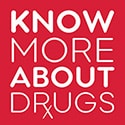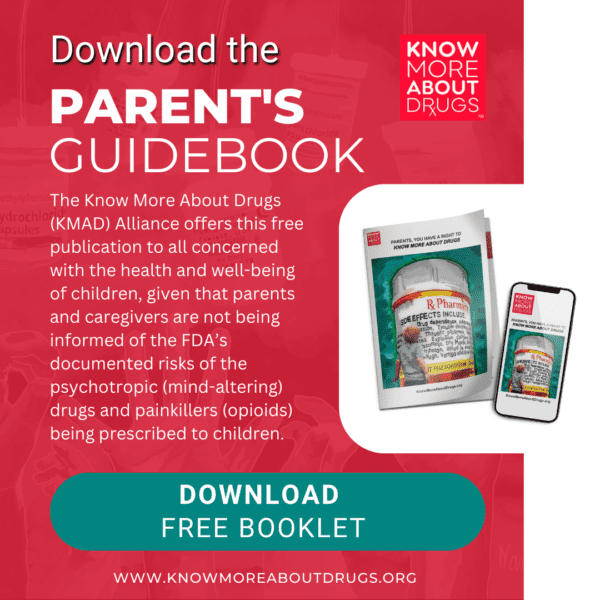Why I believe every parent should utilize the FDA’s MedGuides in order to prevent serious adverse side effects.
I was not surprised when I learned a young teen I have been working with attempted to hang herself with a sweater in the school’s bathroom stall. Nor was I shocked when I learned this same 8th grader attempted to hang herself in her bedroom the year before. What I wonder now is how and when did these heartbreaking, gut wrenching events cease to stun me?
What I know is somewhere along my journey as a nurse and an attorney I began to see a disturbing correlation between children being prescribed psychiatric medication and an increase in acts of self-harm. When I was a nursing student, one semester and clinical rotation was dedicated to psychiatry. That section contained little, if any, teachings related to medicating children for depression, concentration or behavior. As an attorney, I began working with children caught up in the juvenile or family court system. To no one’s surprise, these children exhibited signs of anxiety, confusion and anger.
For the past twenty-five years, I have witnessed a gradual acceleration in the prescription of psychiatric drugs for ADD/ADHD, anxiety, depression, sleep disturbances and behavioral changes. Simultaneously, I have observed an increase in acts of self-harm, suicidal ideations and psychosocial difficulties among children and adolescents. The National Survey of Children’s Health recently reported 1.2% of children aged 3-5 years old; 7.6% of children aged 6-11 years old; and 12.9 % of children aged 12 – 17 years old are on “medication for ADD/ADHD, autism/ASD, or difficulties with emotions, concentration, or behavior”. And oftentimes more than one medication is prescribed. The rise in polypharmacy has outpaced our understanding of how drug interactions affect the developing brain.
The National Survey of Children’s Health recently reported 1.2% of children aged 3-5 years old; 7.6% of children aged 6-11 years old; and 12.9 % of children aged 12 – 17 years old are on “medication for ADD/ADHD, autism/ASD, or difficulties with emotions, concentration, or behavior”.
If our goal is to help children in distress, the first step must be to arm ourselves with as much information as possible. The young teen I mentioned earlier had been prescribed Prozac, Zoloft, fluoxetine, Buspar, Atarax and melatonin. Each time a new diagnosis was added (migraines, PTSD, suicidal ideations, anxiety, depression, sleep disturbance with nightmares) or an act of self-harm occurred, another medication was added. Neither parent had been educated on the risks associated with each medication (and certainly not in combination) so their feeling of helplessness was understandable. To date, nothing had been working to ease their daughter’s distress and no other lifeline was being offered. The question of why their daughter’s symptoms had worsened was going unanswered.
If our goal is to help children in distress, the first step must be to arm ourselves with as much information as possible.
If you are here reading this blog, chances are these behaviors, diagnoses, medications and statistics are familiar and have in some way touched your life—whether it is through your work with children or the care you are providing your own child. The first step in meeting the needs of these children is to gather as much information as possible and that includes an understanding of the medications prescribed. A comprehensive starting point is the Know More About Drugs website. This alliance provides information related to the psychiatric drugs being prescribed to children. At the core of this central point of reference is the FDA Medication Guides. MedGuides are U.S. Food and Drug Administration-approved documents that address the issues specific to a particular drug in order to help avoid serious side effects.
The first step in meeting the needs of these children is to gather as much information as possible and that includes an understanding of the medications prescribed.
The FDA requires the MedGuides be issued with certain prescribed drugs when it has been determined the information provided is necessary to prevent serious adverse effects; and that the patient decision-making should be based on information about a known serious side effect and patient adherence to directions for use are essential to effectiveness. Listed in alphabetical order, each drug is linked to the information needed to help parents and care providers make an informed decision regarding the administration of these medications.
The FDA requires the MedGuides be issued with certain prescribed drugs when it has been determined the information provided is necessary to prevent serious adverse effects;
Make accessing this information your first step toward informed decision making. Once informed, you will then be able to provide the safest and most effective intervention for a child in distress.
Camille L. Harlan RN, JD, CLCP
December 20, 2021
Why I support the Alliance to empower parents with documented risks of prescribed psychotropic drugs on children
This will be my first-ever blog article, and it is with great humility that I am allowed to be an Alliance Member to “Know More About Drugs” (KMAD). First, let me provide you a little background about me.
I am a licensed clinical psychologist (in Wisconsin), a former Chief Psychologist for the Dept. of Corrections in WI, a former disability examiner for Social Security Administration, the past Executive Director of the International Society for Ethical Psychology and Psychiatry and the former Clinical Director of a doctoral training program here in WI. I have expertise in long-term psychotropic drug outcome studies, forensic clinical psychology and working with children and young adults. I have provided written testimony and research to the FDA—helping establish the Black Box warning labels on SSRI antidepressants—been an invited guest speaker to both the United States Congress and Senate of Mexico—speaking about psychiatric drug induced violence and suicide in children and young adults—and I conduct treatment consultations throughout the country. My wife and I also have been together for 32 years and have two wonderful teenagers who are having to navigate the challenges of our society.
Knowledge about KMAD is so greatly needed, as it literally saves the lives of children, teens and their families.
KMAD is about information and informed consent. It is empowering parents by giving them the knowledge and facts, right from the FDA, about the risks of psychotropic drugs being recommended for their child. These FDA Medication Guides (MedGuides) and information they provide, alert parents to the fact that many of these drugs may increase the symptoms they want to reduce, may create new severe adverse reactions, may create dependence, and may cause their child to commit suicide and acts of violence if left unchecked – and without much notice. According to Jim Gottstein, Harvard graduate attorney, “These facts are virtually never disclosed to patients, thus breaching the obligation to obtain informed consent, and often legally constituting battery.”
It is empowering parents by giving them the knowledge and facts, right from the FDA, about the risks of psychotropic drugs being recommended for their child.
I hope you find this blog informative and enjoyable. I will be sharing research, information about how mind-altering psychotropic drugs impact psychological development, a few personal stories and photos, and certainly my own emotional reactions to both success stories and tragedies currently happening. Future blogs will feature at least a few article topics and or facts that parents and readers can use in their own lives, and with their own children. I look forward to us getting to Know More About Drugs…together!
So let’s start off with something positive. I referred a mother to the Know More About Drugs website about a month ago, as she had numerous questions about whether certain prescribed drugs could cause the unusual behavior she was seeing in her son. She indicated that she had already called the prescribing doctor and could not get in to see him for over a month. The mother said that a nurse who spoke to her, indicated the medications her son was taking would not be causing her son to exhibit the behavior she was starting to see. When she heard about the work that I do, she contacted me and I was able to refer to her the FDA Medication Guides through the KMAD website, so she could learn right from the source. The child had originally been seen for problems with test-taking and “blanking out” in school. He was placed on Adderall, and then months later when he was not eating much, becoming aggressive, not sleeping well and having arguments that led to crying, he was prescribed Prozac, reportedly for depression. All the behavioral and emotional problems began to increase months later, and the mother questioned if the medications could have been causing the worsening of “symptoms” (i.e. behaviors, thoughts and feelings).
Upon reading the Medication Guides on both Adderall and Prozac, she realized that all the concerning behaviors and worsening thoughts could be caused by the very medications her doctor was recommending to increase (per her son’s last appointment).
Now, I would love to say that the story was simple and the mother took this new information, got her son off the drugs, and all the bad stuff went away, but that is not what happened. Instead, the mother did research on how to taper him off the medications, began doing this against my advice, as it is vital to have an MD supervising any such changes in medications, and subsequently she began to see her son becoming even more aggressive, have worsening sleep problems and worsening behavior in school. However, the mom knew this might occur because these medications can cause dependence—both psychologically and physiologically, so she persevered in tapering off the medications. I am happy to say that a few months later, her son was off all medications, was working with a counselor and doing Mindfulness skill training and Nurtured Heart techniques. He was also sleeping well through the night, not showing any verbal or behavioral aggression, and getting great daily teacher feedback.
Had it not been for this mother doing her own research, with the help of KMAD, this child may have been just another child that I get to see in residential care, a group home, the prison system or in a hospital. This is not meant to be alarming, as I unfortunately hear story after story of an initial positive response, followed by a progressive worsening of living for so many children.
That said, I want to reiterate that any parents who are considering taking their child off any psychotropic drug, only do so under doctor’s supervision, as withdrawal from these drugs can range from mild to severe.
I am thrilled that KMAD is here to assist parents in learning more about the drugs being recommended for their child. Having the ability to know this information before starting a recommended psychotropic mind-altering drug is so important.
Welcome to being a critical thinker, flexible and open-minded about the pros and cons of recommended psychotropic drugs. Knowing how a drug might impact your child increases your ability to make informed decisions and keep your family safe. Do your teens know this information? They should, as it is their bodies and futures.
Warmly,
“Dr. Toby”
Why I believe every parent should utilize the FDA’s MedGuides in order to prevent serious adverse side effects.
I was not surprised when I learned a young teen I have been working with attempted to hang herself with a sweater in the school’s bathroom stall. Nor was I shocked when I learned this same 8th grader attempted to hang herself in her bedroom the year before. What I wonder now is how and when did these heartbreaking, gut wrenching events cease to stun me?
What I know is somewhere along my journey as a nurse and an attorney I began to see a disturbing correlation between children being prescribed psychiatric medication and an increase in acts of self-harm. When I was a nursing student, one semester and clinical rotation was dedicated to psychiatry. That section contained little, if any, teachings related to medicating children for depression, concentration or behavior. As an attorney, I began working with children caught up in the juvenile or family court system. To no one’s surprise, these children exhibited signs of anxiety, confusion and anger.
For the past twenty-five years, I have witnessed a gradual acceleration in the prescription of psychiatric drugs for ADD/ADHD, anxiety, depression, sleep disturbances and behavioral changes. Simultaneously, I have observed an increase in acts of self-harm, suicidal ideations and psychosocial difficulties among children and adolescents. The National Survey of Children’s Health recently reported 1.2% of children aged 3-5 years old; 7.6% of children aged 6-11 years old; and 12.9 % of children aged 12 – 17 years old are on “medication for ADD/ADHD, autism/ASD, or difficulties with emotions, concentration, or behavior”. And oftentimes more than one medication is prescribed. The rise in polypharmacy has outpaced our understanding of how drug interactions affect the developing brain.
The National Survey of Children’s Health recently reported 1.2% of children aged 3-5 years old; 7.6% of children aged 6-11 years old; and 12.9 % of children aged 12 – 17 years old are on “medication for ADD/ADHD, autism/ASD, or difficulties with emotions, concentration, or behavior”.
If our goal is to help children in distress, the first step must be to arm ourselves with as much information as possible. The young teen I mentioned earlier had been prescribed Prozac, Zoloft, fluoxetine, Buspar, Atarax and melatonin. Each time a new diagnosis was added (migraines, PTSD, suicidal ideations, anxiety, depression, sleep disturbance with nightmares) or an act of self-harm occurred, another medication was added. Neither parent had been educated on the risks associated with each medication (and certainly not in combination) so their feeling of helplessness was understandable. To date, nothing had been working to ease their daughter’s distress and no other lifeline was being offered. The question of why their daughter’s symptoms had worsened was going unanswered.
If our goal is to help children in distress, the first step must be to arm ourselves with as much information as possible.
If you are here reading this blog, chances are these behaviors, diagnoses, medications and statistics are familiar and have in some way touched your life—whether it is through your work with children or the care you are providing your own child. The first step in meeting the needs of these children is to gather as much information as possible and that includes an understanding of the medications prescribed. A comprehensive starting point is the Know More About Drugs website. This alliance provides information related to the psychiatric drugs being prescribed to children. At the core of this central point of reference is the FDA Medication Guides. MedGuides are U.S. Food and Drug Administration-approved documents that address the issues specific to a particular drug in order to help avoid serious side effects.
The first step in meeting the needs of these children is to gather as much information as possible and that includes an understanding of the medications prescribed.
The FDA requires the MedGuides be issued with certain prescribed drugs when it has been determined the information provided is necessary to prevent serious adverse effects; and that the patient decision-making should be based on information about a known serious side effect and patient adherence to directions for use are essential to effectiveness. Listed in alphabetical order, each drug is linked to the information needed to help parents and care providers make an informed decision regarding the administration of these medications.
The FDA requires the MedGuides be issued with certain prescribed drugs when it has been determined the information provided is necessary to prevent serious adverse effects;
Make accessing this information your first step toward informed decision making. Once informed, you will then be able to provide the safest and most effective intervention for a child in distress.
Camille L. Harlan RN, JD, CLCP
December 20, 2021
Why I believe every parent should utilize the FDA’s MedGuides in order to prevent serious adverse side effects.
I was not surprised when I learned a young teen I have been working with attempted to hang herself with a sweater in the school’s bathroom stall. Nor was I shocked when I learned this same 8th grader attempted to hang herself in her bedroom the year before. What I wonder now is how and when did these heartbreaking, gut wrenching events cease to stun me?
What I know is somewhere along my journey as a nurse and an attorney I began to see a disturbing correlation between children being prescribed psychiatric medication and an increase in acts of self-harm. When I was a nursing student, one semester and clinical rotation was dedicated to psychiatry. That section contained little, if any, teachings related to medicating children for depression, concentration or behavior. As an attorney, I began working with children caught up in the juvenile or family court system. To no one’s surprise, these children exhibited signs of anxiety, confusion and anger.
For the past twenty-five years, I have witnessed a gradual acceleration in the prescription of psychiatric drugs for ADD/ADHD, anxiety, depression, sleep disturbances and behavioral changes. Simultaneously, I have observed an increase in acts of self-harm, suicidal ideations and psychosocial difficulties among children and adolescents. The National Survey of Children’s Health recently reported 1.2% of children aged 3-5 years old; 7.6% of children aged 6-11 years old; and 12.9 % of children aged 12 – 17 years old are on “medication for ADD/ADHD, autism/ASD, or difficulties with emotions, concentration, or behavior”. And oftentimes more than one medication is prescribed. The rise in polypharmacy has outpaced our understanding of how drug interactions affect the developing brain.
The National Survey of Children’s Health recently reported 1.2% of children aged 3-5 years old; 7.6% of children aged 6-11 years old; and 12.9 % of children aged 12 – 17 years old are on “medication for ADD/ADHD, autism/ASD, or difficulties with emotions, concentration, or behavior”.
If our goal is to help children in distress, the first step must be to arm ourselves with as much information as possible. The young teen I mentioned earlier had been prescribed Prozac, Zoloft, fluoxetine, Buspar, Atarax and melatonin. Each time a new diagnosis was added (migraines, PTSD, suicidal ideations, anxiety, depression, sleep disturbance with nightmares) or an act of self-harm occurred, another medication was added. Neither parent had been educated on the risks associated with each medication (and certainly not in combination) so their feeling of helplessness was understandable. To date, nothing had been working to ease their daughter’s distress and no other lifeline was being offered. The question of why their daughter’s symptoms had worsened was going unanswered.
If our goal is to help children in distress, the first step must be to arm ourselves with as much information as possible.
If you are here reading this blog, chances are these behaviors, diagnoses, medications and statistics are familiar and have in some way touched your life—whether it is through your work with children or the care you are providing your own child. The first step in meeting the needs of these children is to gather as much information as possible and that includes an understanding of the medications prescribed. A comprehensive starting point is the Know More About Drugs website. This alliance provides information related to the psychiatric drugs being prescribed to children. At the core of this central point of reference is the FDA Medication Guides. MedGuides are U.S. Food and Drug Administration-approved documents that address the issues specific to a particular drug in order to help avoid serious side effects.
The first step in meeting the needs of these children is to gather as much information as possible and that includes an understanding of the medications prescribed.
The FDA requires the MedGuides be issued with certain prescribed drugs when it has been determined the information provided is necessary to prevent serious adverse effects; and that the patient decision-making should be based on information about a known serious side effect and patient adherence to directions for use are essential to effectiveness. Listed in alphabetical order, each drug is linked to the information needed to help parents and care providers make an informed decision regarding the administration of these medications.
The FDA requires the MedGuides be issued with certain prescribed drugs when it has been determined the information provided is necessary to prevent serious adverse effects;
Make accessing this information your first step toward informed decision making. Once informed, you will then be able to provide the safest and most effective intervention for a child in distress.
Camille L. Harlan RN, JD, CLCP
December 20, 2021

Camille L. Harlan RN, JD, CLCP
Know More About Drugs Alliance Member
I am a registered nurse and an attorney licensed to practice law in Ohio. I began my nursing career in 1981 and worked extensively in a wide range of hospital settings, including Neuro-Medical ICU, the Emergency Department, and as an administrative officer coordinating care for nurses at a regional hospital in Ohio. After graduating from law school in 1994, I expanded my work experience to include representing plaintiffs and defendants in juvenile, family, criminal and probate courts throughout Ohio.
It is the melding of these two careers that placed me in the unique experience of working with children, parents, and guardians in situations far beyond what would be encountered only in their home, school, doctor’s office or a courtroom. As I began to see the clear connection between the use of psychotropic drugs to alter a child’s behavior and the negative consequences, I was able to offer guidance based on the knowledge I had gained as a nurse and an attorney.




